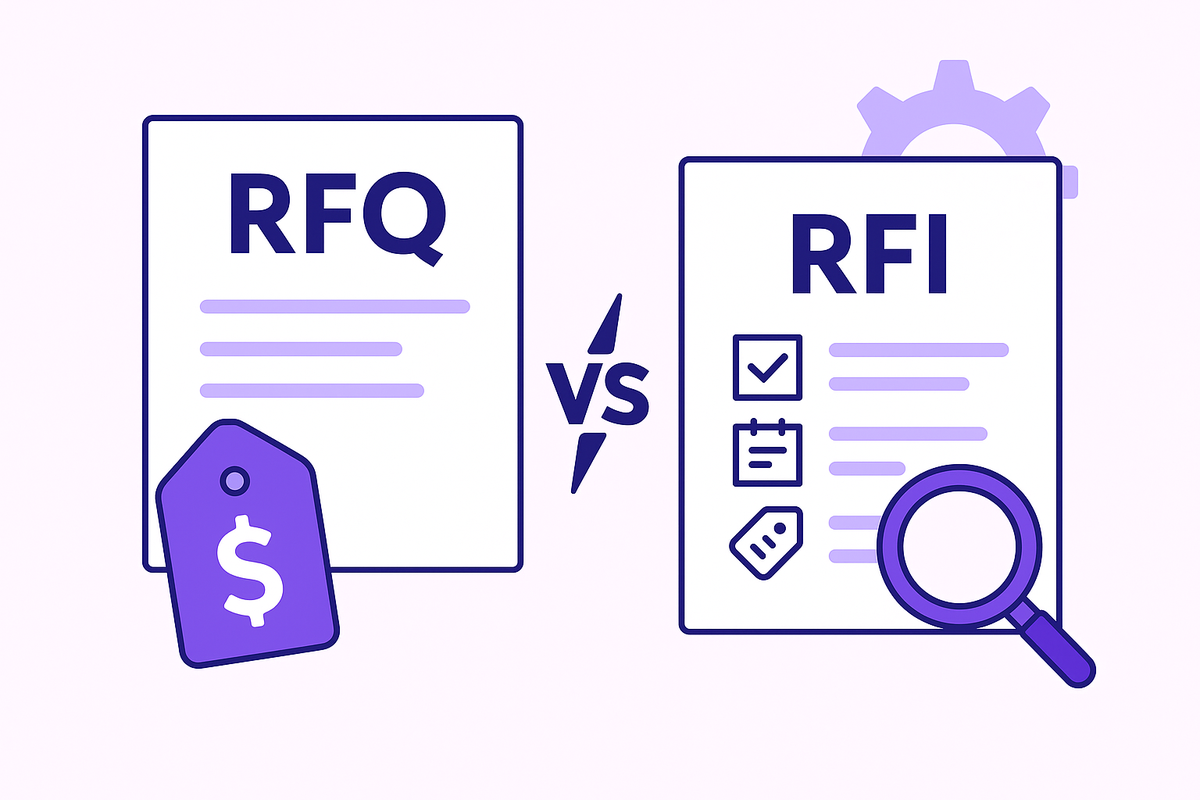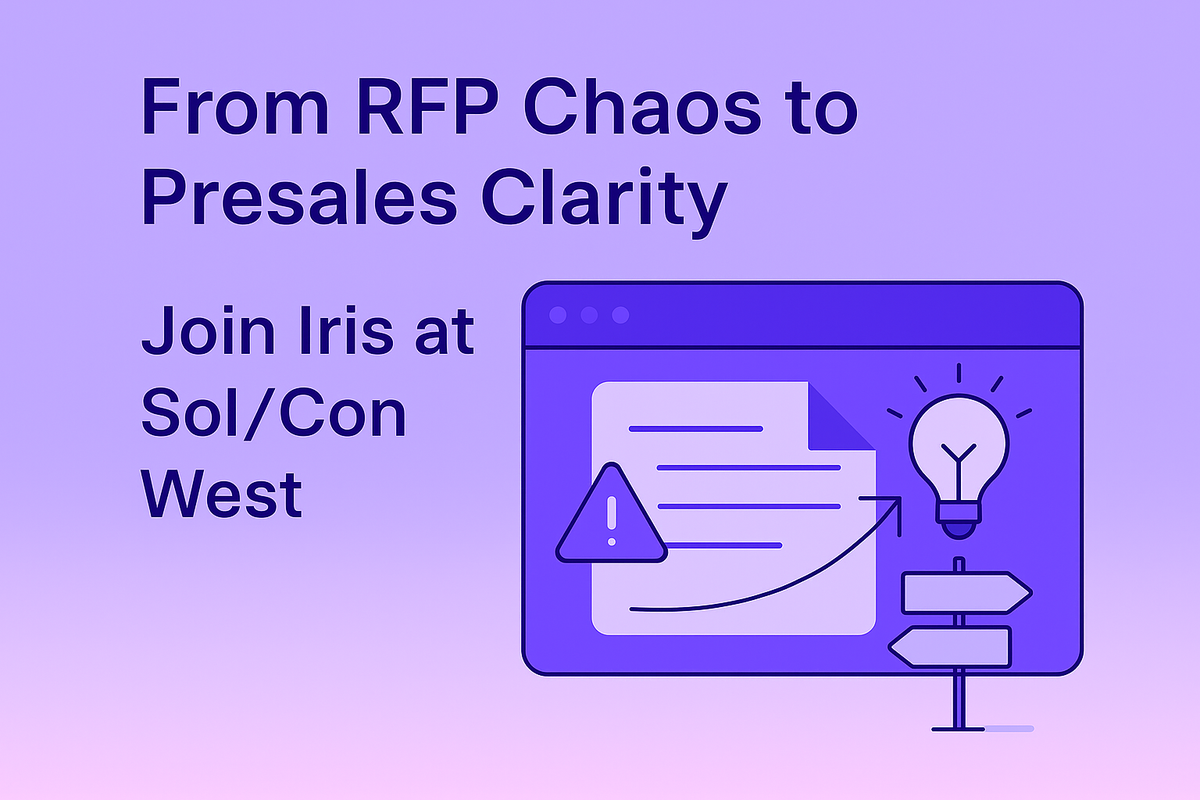RFQ vs RFI: What's the Difference & When to Use Each
August 5, 2025
By
Evie Secilmis

Choosing between an RFI (Request for Information) and an RFQ (Request for Quote) isn’t just procurement vocabulary — it influences timeline, vendor fit, cost, and internal coordination.
Send the wrong one, and you waste everyone's time.
Send the right one, and you accelerate a deal.
This guide covers:
- ✅ RFI meaning (when and why to use one)
- ✅ RFQ meaning (and how it's different)
- ✅ Real examples for each
- ✅ Practical decision rules
- ✅ Best practices to streamline both
- ✅ Ways AI helps teams respond faster
- ✅ SEO-friendly FAQs
What Is an RFI? (RFI Meaning)
A Request for Information (RFI) is used early in the buying process to gather high-level information about possible solutions, capabilities, and vendors before pricing or proposals are requested.
Use an RFI when you need to:
- Understand what's available in the market
- Explore different ways to solve a problem
- Compare vendor capabilities
- Clarify requirements internally
- Build a shortlist before moving to formal evaluation
📘 Learn more:
What Is a Request for Information (RFI)?
When an RFI Is the Right Move
An RFI is ideal when:
- The problem can be solved multiple ways
- You're researching emerging technologies
- You don’t yet have clear tech requirements
- You're purchasing a complex solution (not commodity goods)
- You need vendor input to shape scope
Examples:
- Evaluating custom software solutions
- Exploring AI and workflow automation platforms
- Assessing security and compliance capabilities
- Entering a new vendor category
RFIs help you gather insights, refine scope, and avoid expensive wrong turns later.
What Is an RFQ? (RFQ Meaning)
A Request for Quote (RFQ) is used when requirements are known and buyers need firm pricing and terms.
Use an RFQ when you:
- Know exactly what you need
- Are evaluating cost differences between vendors
- Have a fixed scope, volume, or specifications
- Want to move quickly into procurement
📘 Learn more:
What Is a Request for Quote (RFQ)?
RFI vs RFQ: Key Differences
Where RFPs Fit In
When an RFI Is the Right Move
Use a Request for Information (RFI) when you're still in the exploratory phase and need clarity before committing to vendors or scope. RFIs are ideal when:
- Requirements aren't fully defined
- Multiple solutions could work
- You're entering a new category or evaluating new technology
- You need vendor input to shape your path
Examples include exploring custom software, AI tools, or new industry solutions.
Learn more about what an RFI includes in our
Request for Information guide.
The Payoff: RFQs vs RFIs
Why RFQs Save Time & Money
- Competitive pricing
- Clear expectations and specs
- Fast, structured procurement cycles
See how this ties into modern workflows in our
Procurement Automation overview.
Why RFIs Drive Better Decisions
- Understand solutions before pricing
- Reduce risk and avoid rework
- Surface qualified vendors early
Explore how PreSales Automation and content intelligence improve upstream discovery.
Best Practices for RFIs & RFQs
- Be clear and concise
- Set realistic deadlines
- Evaluate beyond price
- Use templates to standardize
Related reading:
Common Mistake: Using the Wrong Tool
One of the biggest procurement mistakes is sending an RFQ too early, before scope is defined. That leads to:
- Inaccurate quotes
- Vendor confusion
- Wasted cycles
Each request serves a different step:
Move Beyond Manual RFIs & RFQs
If RFIs, RFPs, and RFQs still live in emails, spreadsheets, or shared drives, it’s time to modernize.
With Iris, teams:
✅ Generate accurate draft responses instantly
✅ Tag SMEs and track approvals
✅ Maintain a single source of truth
✅ Cut response time by 50–70%
Making the Right Choice
- Use an RFI to learn
- Use an RFP to evaluate solutions
- Use an RFQ to finalize pricing
Explore each:
Final Takeaway
RFIs and RFQs aren’t paperwork — they’re decision accelerators.
Used correctly, they:
- Speed evaluation
- Improve vendor fit
- Strengthen internal alignment
- Protect time & resources
Used incorrectly, they create confusion and delays.
Ready to streamline RFIs, RFPs, & RFQs?
See how Iris helps proposal, sales engineering, and security teams respond faster with less effort.
Share this post
Link copied!




















